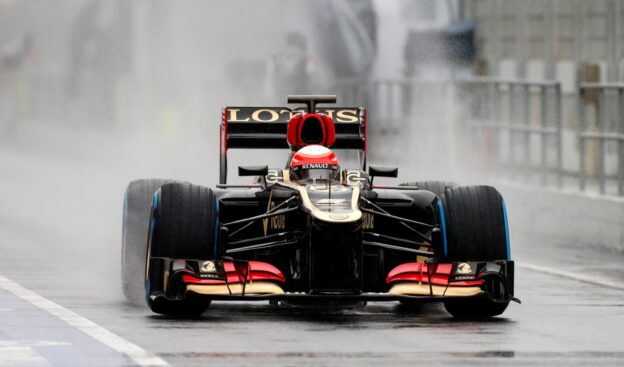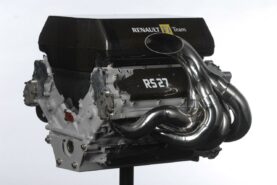Review of first 2013 Official Formula 1 Test in Barcelona

All The Formula 1 teams encountered wet weather for the first time this year on the final day of the first four-day winter test at Catalunya circuit in Barcelona. This last weeks testing session was the second of three official pre-season tests. The first three days of last week testing were dry. In this dry weather all teams where able to run through the complete range of Pirelli dry weather tyres. However, some unusually cold conditions restricted the amount of meaningful data that could be accumulated from the F1 tests. The final pre-season winter testing sesssion will also take place on Catalunya circuit n Barcelona next week, from February 28th to March 3rd.
Winter testing quote by Paul Hembery (Pirelli motorsport director):
“The teams experienced quite high degradation in Barcelona, and that was really down to the weather conditions. The conditions we had in Barcelona are far from typical of the rest of the season, with much cooler ambient and track temperatures than we would normally race in, and even some rain on the final day. This put the tyres outside of their usual working ranges, which led to problems such as graining. The conditions were particularly unsuited to the supersoft tyre, due to the circuit layout and the roughness of the surface in addition to the cold temperatures. Coupled with the fact that teams are still making big set-up adjustments to their new cars and trying out our complete range of our tyres to optimise the package, we saw levels of degradation that are not typical. Once we get to Melbourne the tyres should be much more within their intended working range, which will eliminate the unusual amount of degradation that some teams have experienced.”
Testing Facts:
- The teams are allocated 100 sets of tyres per car per year for testing purposes. After an initial contact with the 2013 range for the first time in Jerez, they again concentrated on expanding their knowledge of the new tyre characteristics this year, and how they interact with the new cars: all of which were present for the first time in Barcelona.
- Ambient and track temperatures were cool: generally between 10 to 15 degrees centigrade ambient, which was on the whole cooler than the previous Jerez test. This led to some graining, which occurs when a tyre slides if it is not up to temperature, with the friction against the track surface tearing off strips of rubber.
- With most of the initial work on new cars already completed in Jerez, the teams were able to also focus on longer runs and race simulations with varying fuel loads. Between two and three pit stops are expected at the first grand prix in Australia: some of the teams that carried out race simulations stopped the equivalent of four times in Barcelona, demonstrating that the ideal target should be met in the more typical conditions of Melbourne.
More Testing Facts:
- The time difference between the slick compounds was in the region of 0.5s per lap, but the unusual weather conditions in Barcelona meant that this was not entirely conclusive.
- Most laps of Barcelona: V Bottas – 355 laps; F Alonso – 283 laps; M Chilton – 241 laps
- The teams sampled the Cinturato Green intermediate and the Cinturato Blue full wet tyre for the first time on Friday. The wet-weather tyres have a new rear construction this year, which improves traction at the rear in particular and reduces snap oversteer.
- The fastest overall time of the test set by Fernando Alonso on day three (1m21.875s) comfortably beat the fastest time during testing last year at Barcelona: 1m22.030s (set by Kimi Raikkonen, Lotus).
- Barcelona is an extremely technical circuit that tests most aspects of a car’s overall performance. The most stressed tyres at the Circuit de Catalunya are those on the left.
Testing numbers:
- Total number of sets brought to Barcelona: 385 sets which equals 1.628 tyres
- of which supersoft tyres: 24 sets
- of which soft tyres: 87 sets
- of which medium tyres: 132 sets
- of which hard tyres: 97 sets
- of which intermediate tyres: 40 sets
- of which wet tyres: 27 sets
- Total amount of sets used: 303
- of which supersoft tyres: 5 sets
- of which soft tyres: 53 sets
- of which medium tyres: 127 sets
- of which hard tyres: 84 sets
- of which intermediate tyres: 24 sets
- of which wet tyres: 10 sets
- Longest run: 24 laps on the hard compound
36 laps of the medium compound
31 laps on the soft compound
16 laps on the supersoft compound
29 laps on the intermediate compound
22 laps on the wet compound
- Highest / lowest ambient temperature over four days: 20 °C (Day 2) / 7 °C (Day 4)
- Highest / lowest track temperature over four days: 26 °C (Day 2) / 6 °C (Day 4)
Quickest Testing Lap Times first week Barcelona:
Day 1
| 1. | Rosberg, Mercedes | 1’22’’616s | Medium New |
| 2. | Räikkönen, Lotus | 1’22’’623s | Medium New |
| 3. | Alonso, Ferrari | 1’22’952s | Medium New |
Day 2
| 1. | Perez, McLaren | 1’21’’848 | Soft New |
| 2. | Vettel, Red Bull | 1’22’’197 | Soft New |
| 3. | Räikkönen, Lotus | 1’22’’697 | Medium New |
Day 3
| 1. | Alonso, Ferrari | 1’21’’875 | Soft New |
| 2. | Hülkenberg, Sauber | 1’22’160 | Soft New |
| 3. | Grosjean, Lotus | 1’22’188 | Soft New |
Day 4
| 1. | Hamilton, Mercedes | 1’23’’282 | Medium New |
| 2. | Button, McLaren | 1’23’633 | Medium New |
| 3. | Vergne, Toro Rosso | 1’24’’071 | Soft New |
✅ Check out more posts with related topics:














LAST 3 F1 Fan COMMENTS